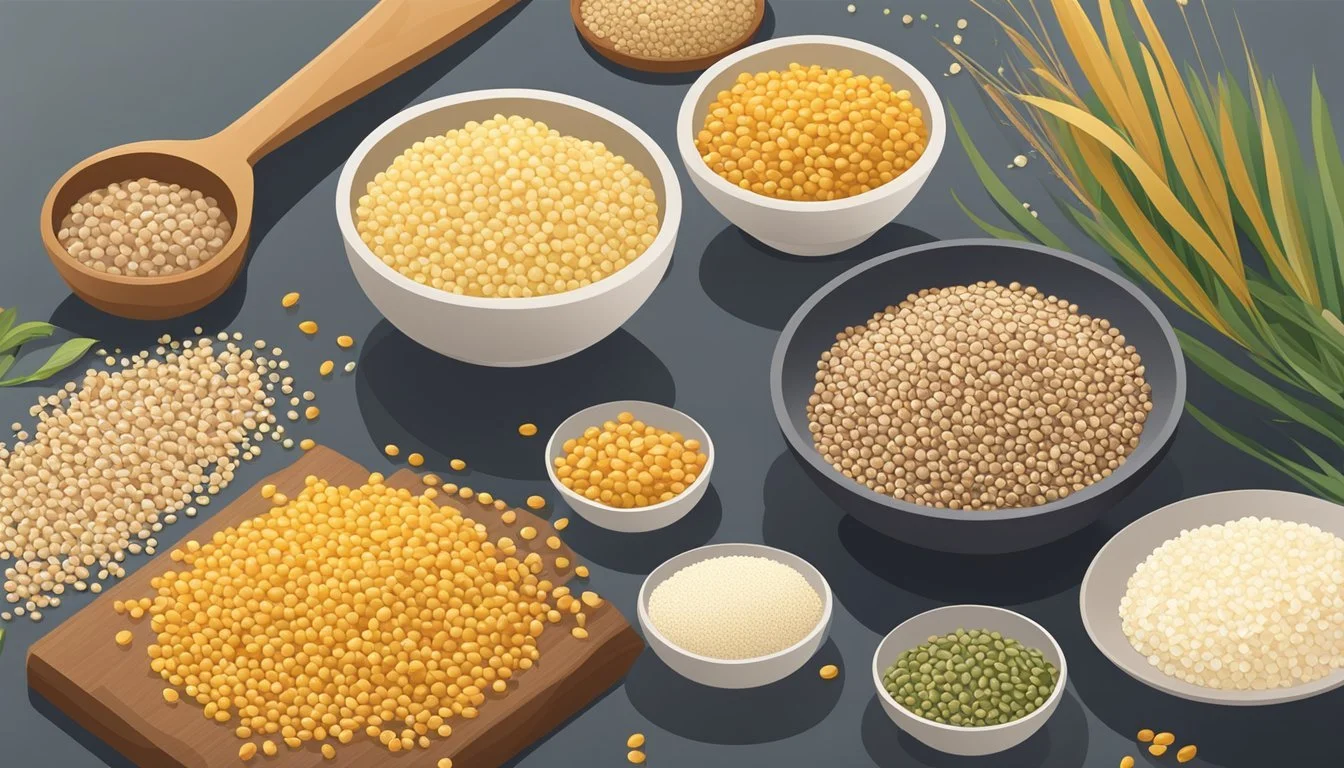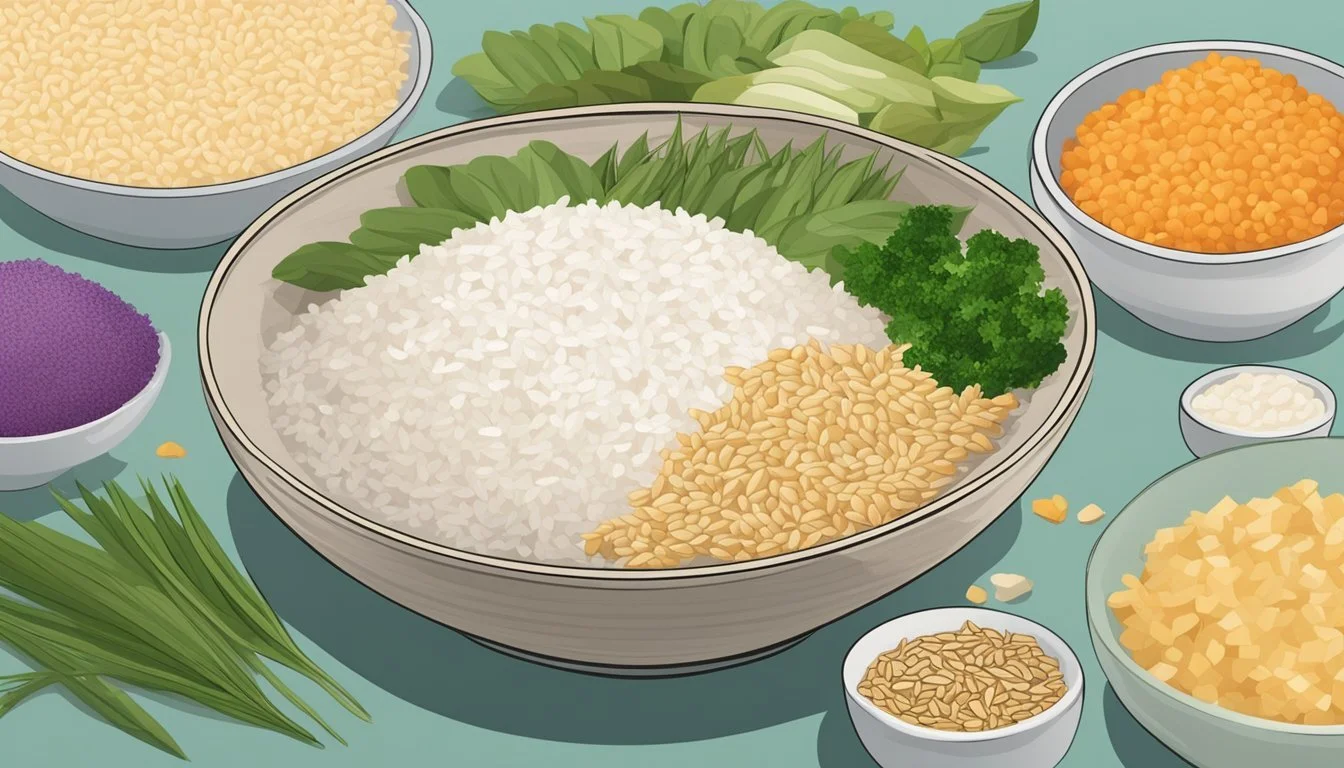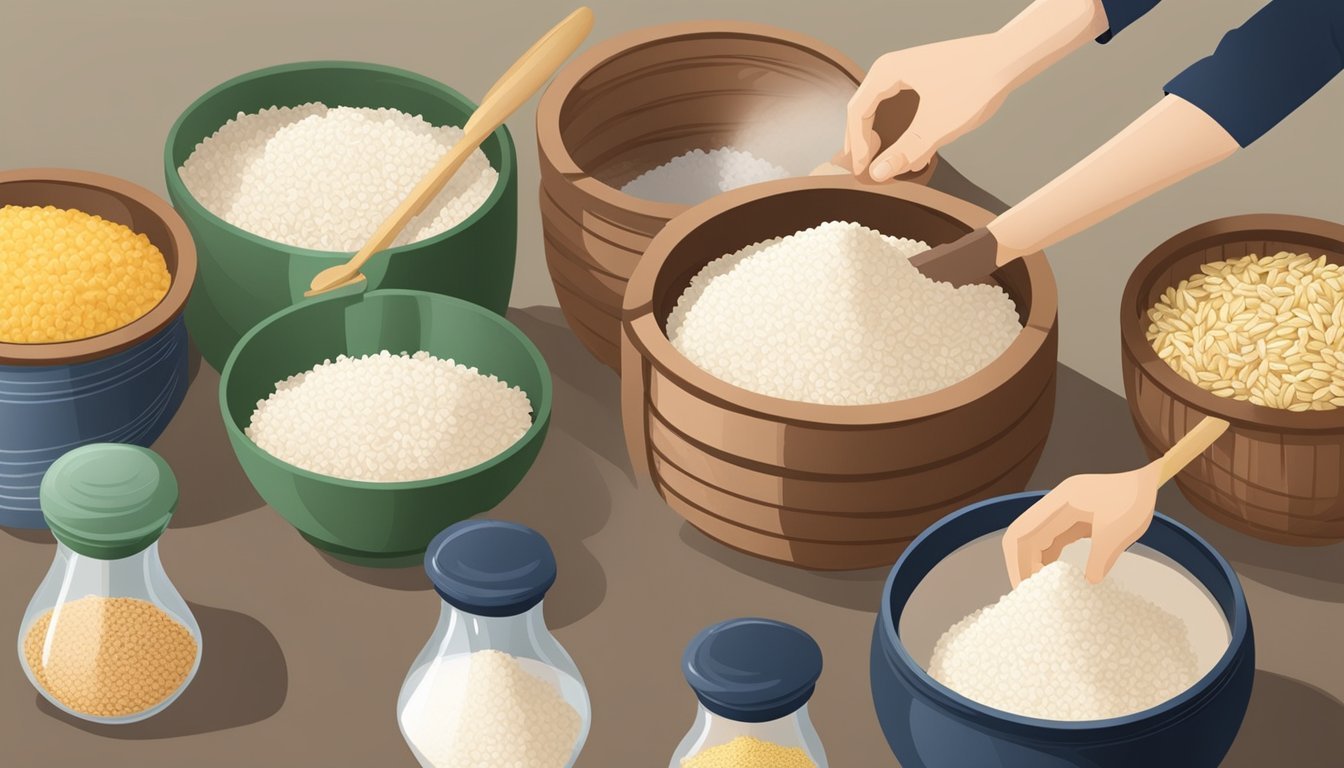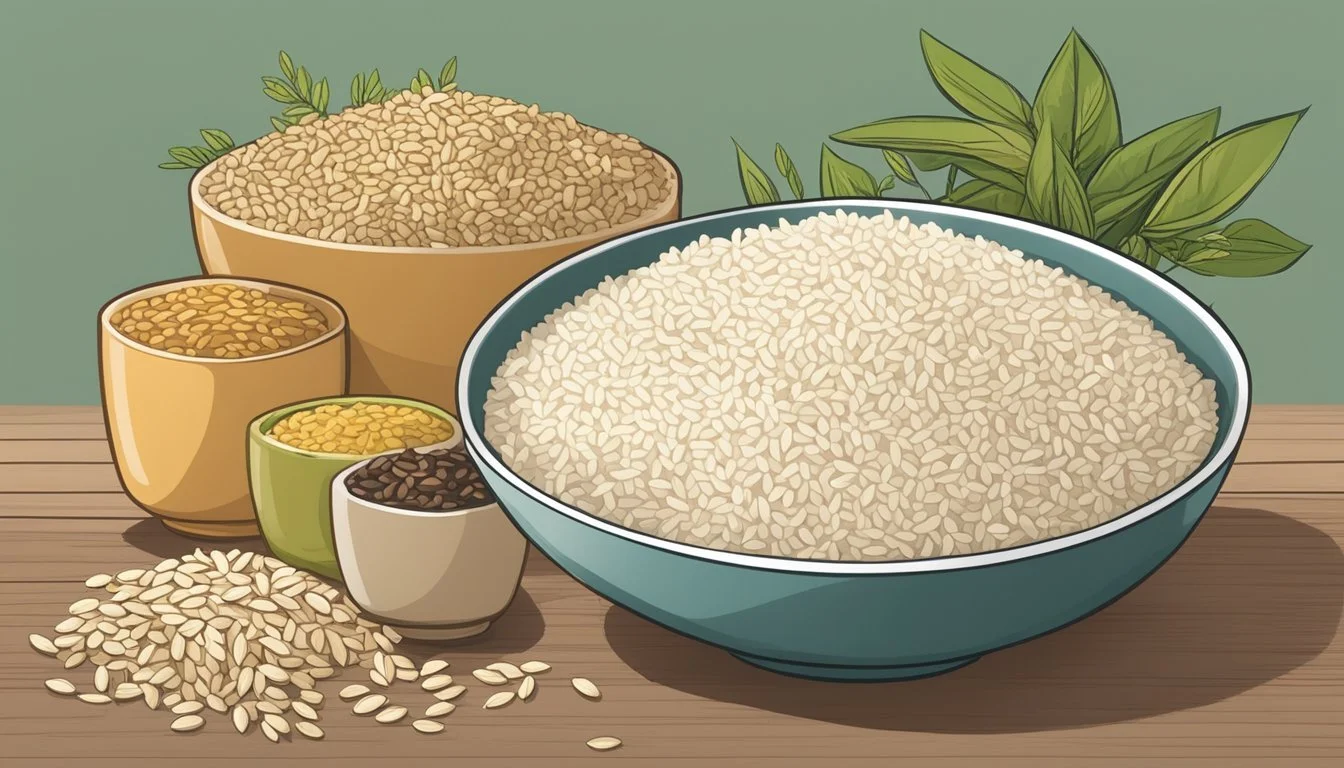Jasmine Rice Substitutes
Top Alternatives for Your Recipes
Cooking a dish that calls for jasmine rice but don't have any on hand? There are several excellent substitutes for jasmine rice that can provide similar texture and flavor to your recipes. Whether you’re looking for a whole grain option like brown rice, which offers a nutty flavor and chewy texture, or you need something with a slightly sticky consistency like basmati rice, alternatives are readily available.
Brown rice provides a more robust taste and is an excellent source of fiber and vitamins, making it a healthy substitute in many dishes. On the other hand, basmati rice brings a similarly aromatic experience and slight stickiness that can mimic jasmine rice in Asian-inspired cuisines such as Thai green curry or stir-fries.
Another versatile option is long-grain white rice, which can closely match jasmine rice’s texture. While it may lack the aromatic qualities, it’s still a viable substitute that cooks quickly and fits well in most recipes.
Understanding Jasmine Rice
Jasmine rice is renowned for its unique flavor and aromatic qualities, as well as its distinct texture. These characteristics make it a popular choice in various cuisines.
Flavor and Aroma Profile
Jasmine rice is noted for its delicate, floral aroma and slightly nutty flavor. The grains release fragrant floral notes when cooked, which can enhance the sensory appeal of a dish. This fragrant quality is a key reason why Jasmine rice is favored in many Asian culinary traditions.
The flavor profile of Jasmine rice is subtle yet distinct, providing a pleasant aromatic experience without overwhelming other ingredients. It pairs well with a wide range of flavors, from the bold spices in Thai curries to the milder tastes in steamed dishes.
Texture Characteristics
The texture of Jasmine rice is an essential aspect of its appeal. When cooked properly, it develops a slightly sticky quality that makes it ideal for dishes that benefit from grains that hold together. This stickiness helps the rice to clump slightly without becoming mushy.
Fluffy texture with individual grains remaining partly distinct is another hallmark of Jasmine rice. This textural attribute makes it versatile for various dishes, from stir-fries to plain steamed rice served alongside main courses. The balance between being sticky and fluffy is what sets Jasmine rice apart from other types of rice.
Health and Nutritional Considerations
Different substitutes for jasmine rice come with unique health benefits, including varied carbohydrate profiles, protein content, and vitamins. Selecting the right alternative can significantly impact one's nutritional intake and overall wellbeing.
Carbohydrates and Glycemic Index
Jasmine rice is known for its high carbohydrate content, which can influence blood sugar levels. Substitutes like quinoa and farro offer a lower glycemic index, making them preferable for those managing blood sugar levels. These alternatives digest slower, leading to a gradual increase in blood sugar.
On the other hand, barley also provides a healthier option with its low glycemic index. Including these substitutes in the diet can help maintain stable energy levels and support long-term health outcomes.
Protein and Fiber Content
One of the key benefits of choosing substitutes for jasmine rice is the potential for increased protein and fiber intake. Quinoa is notable for its high protein content, making it a superb choice for individuals looking to boost their daily protein intake. Additionally, it contains more fiber than jasmine rice, aiding in digestion and promoting a feeling of fullness.
Farro and barley also offer higher protein and fiber levels, contributing to overall digestive health. These grains help in muscle repair and enhance dietary satisfaction, which can be particularly beneficial for those following a high-protein diet or seeking to manage weight.
Vitamins and Minerals
Consuming a diverse range of grains ensures a rich intake of essential vitamins and minerals. Quinoa is packed with antioxidants and nutrients such as magnesium, iron, and B vitamins. These contribute to various bodily functions, including energy production and immune support.
Farro and barley provide valuable minerals like iron and zinc, as well as vitamins such as vitamin C. Including these grains in place of jasmine rice can lead to a more nutrient-dense diet, supporting overall health and wellbeing.
Using these substitutes can therefore provide significant health benefits, ensuring a diverse and nutritious diet.
Culinary Uses of Jasmine Rice
Jasmine rice, known for its fragrant aroma and delicate texture, plays a crucial role in many culinary traditions. It excels in both traditional Asian dishes and diverse global recipes, offering versatility in various cooking methods.
Traditional Asian Dishes
Jasmine rice is a staple in Thai cuisine, complementing dishes like curries and stir-fries. Its fragrance enhances the flavors of spicy curries, such as Green Curry and Massaman Curry.
In Indian cuisine, jasmine rice can be used for Biryani, though Basmati is more common. It's also ideal in Indonesian Nasi Goreng, a popular fried rice dish, where its scent pairs well with the spices and herbs used.
Global Cuisine and Fusion
Beyond Asia, jasmine rice finds a place in global cuisines. It serves as a base for many fusion dishes, such as rice bowls topped with a mix of meats, vegetables, and sauces from different culinary traditions. In Mexican cuisine, it's sometimes used instead of traditional white rice in dishes like rice salads and burrito bowls.
Rice puddings benefit from jasmine rice's creamy texture and subtle flavor, making it a versatile ingredient in desserts across Europe and the Americas. Its unique characteristics bring an unexpected twist to these traditional comfort foods.
Versatility in Cooking
The versatile nature of jasmine rice is a boon to home cooks and chefs alike. It performs well in both savory and sweet recipes. For salads, jasmine rice's slight stickiness helps to hold grains together, making it a good choice for cold dishes.
In soups and broths, jasmine rice adds body and texture without overpowering other ingredients. Its mild flavor allows it to absorb the tastes of accompanying spices and herbs, making it a versatile component in many recipes.
Top Substitutes for Jasmine Rice
When Jasmine rice is not available, several other options can work well depending on the recipe and dietary needs. This section explores various substitutes that can mimic Jasmine rice's texture, taste, or nutritional profile.
Whole Grain Alternatives
Brown Rice Brown rice is a whole grain known for its nutty flavor and chewy texture. It is rich in fiber, vitamins, and minerals. Brown rice can substitute for Jasmine rice in many dishes, such as stir-fries and casseroles. Though it takes longer to cook, its robust flavor pairs well with a variety of ingredients.
Wild Rice Wild rice offers a chewy texture with a distinct, earthy flavor. It is high in protein, fiber, and various micronutrients. While wild rice takes longer to cook, it can be a great substitute for Jasmine rice in soups, salads, and pilafs.
Black Rice Black rice, also known as forbidden rice, has a slightly sweet, nutty flavor and a sticky texture. Rich in antioxidants, it can be a nutritious alternative to Jasmine rice. This rice works well in both savory and sweet dishes, making it versatile for many recipes.
Gluten-Free Options
Quinoa Quinoa is a protein-rich seed often used as a grain. It has a light, fluffy texture and a subtle nutty flavor, making it a good substitute for Jasmine rice in salads, side dishes, and bowls. Its high protein content and gluten-free status make it a popular choice for those with dietary restrictions.
Buckwheat Despite its name, buckwheat is gluten-free and belongs to the amaranth family. It has a slightly bitter taste and offers a chewy texture. Buckwheat can replace Jasmine rice in savory dishes, providing a good source of protein and fiber.
Cauliflower Rice Cauliflower rice is a low-carb, gluten-free alternative. Made by grating or processing cauliflower into rice-sized pieces, it has a neutral flavor and can absorb the seasonings of the dish. It's perfect for stir-fries, burrito bowls, and as a base for various entrees.
Rice Varieties with Similar Qualities
Basmati Rice Basmati rice is another aromatic, long-grain rice with a light, fluffy texture. It's commonly used in Indian and Middle Eastern cuisine. Basmati rice's cooking properties and its fragrant aroma make it an excellent substitute for Jasmine rice in many dishes.
Texmati Rice Texmati rice is an American-grown hybrid of basmati rice. It shares many qualities with Jasmine rice, including its aromatic nature and long grains. Use Texmati rice in any recipe that calls for Jasmine rice, especially where a fragrant, non-sticky rice is desired.
Long-Grain White Rice Long-grain white rice has a mild flavor and fluffy texture. It’s a versatile substitute for Jasmine rice in a variety of dishes, from pilafs to fried rice. Cooking times and water ratios are usually similar, making it an easy swap.
Low-Carb and High-Protein Alternatives
Riced Broccoli Riced broccoli is another low-carb, nutrient-packed option. Like cauliflower rice, it is made by processing broccoli into small, rice-sized pieces. It has a slightly bitter taste but works well in stir-fries, soups, and as a side dish.
Shirataki Rice Shirataki rice is a low-carb alternative made from the konjac plant. It's composed mostly of water and glucomannan fiber, making it extremely low in calories. Its neutral taste allows it to take on the flavors of the dish, making it useful in various rice dishes.
Other Grain Substitutes
Barley Barley is a versatile grain with a chewy texture and nutty flavor. It is high in fiber and can replace Jasmine rice in soups, stews, and salads. Its robust texture makes it suitable for hearty dishes.
Bulgur Bulgur is a quick-cooking whole grain made from cracked wheat. It has a light, nutty flavor and a tender texture. Bulgur can be used in place of Jasmine rice in pilafs, salads, and side dishes.
Farro Farro is an ancient grain with a chewy texture and rich, nutty flavor. It’s high in protein, fiber, and nutrients. Farro can substitute for Jasmine rice in a variety of dishes, including soups, salads, and grain bowls.
Orzo Orzo is a type of pasta shaped like rice grains. Although not a grain, it can be a handy substitute for Jasmine rice in pilafs, soups, and side dishes. Orzo cooks quickly and has a mild flavor, making it versatile for many recipes.
Choosing the Right Substitute
When selecting a substitute for jasmine rice, important factors include the desired taste, appropriate cooking methods, the intended dish outcome, and any specific nutritional needs. These considerations ensure the substitute maintains the integrity of the dish and meets dietary requirements.
Taste and Flavor Considerations
The flavor profile of jasmine rice is subtly sweet with floral notes. Alternatives like basmati rice offer a similar aromatic experience, making it a good replacement for dishes needing a fragrant touch. Brown rice, which has a nuttier flavor and chewier texture, works well in recipes that can handle a more robust taste.
For a neutral flavor, white rice is an option but lacks the distinctive aroma of jasmine rice. Quinoa, though not a grain, brings a nutty flavor and is suitable for various dishes, especially those needing a pronounced taste.
Cooking Methods and Time
Substitute choices should factor in the cooking times and methods. Jasmine rice typically cooks faster than brown rice, which needs more time and liquid. Basmati rice has a similar cooking time to jasmine rice, making it a convenient substitute.
Quinoa requires rinsing before cooking to remove its bitter saponin coating, which could add extra steps. Sushi rice, which is sticky, cooks similarly to jasmine rice and is suitable for dishes needing a pliable texture. Using a rice cooker can simplify cooking timing and methods for these substitutes.
Desired Dish Outcome
The intended dish outcome significantly influences the choice of rice substitutes. For stir-fries and curries, basmati rice provides a fluffy texture that pairs well with saucy dishes. Brown rice's chewy texture is ideal for robust recipes like grain bowls or hearty salads.
For rice pudding, where creaminess is key, white rice's softer texture might be preferable. Sushi rice, due to its sticky nature, is best for sushi rolls or similar recipes needing a cohesive, pliable rice base.
Nutritional Requirements
Nutritional needs play a crucial role in selecting a jasmine rice substitute. Brown rice, being a whole grain, offers higher fiber content and more vitamins compared to white rice. It is beneficial for those seeking more nutritious options.
Quinoa stands out for its high protein content and is gluten-free, making it ideal for individuals with gluten sensitivities or those needing a protein boost. White rice, though less nutrient-dense, serves well for low-fiber diets. Balancing these nutritional attributes ensures the chosen substitute aligns with dietary goals.
Purchase and Storage
Selecting the right jasmine rice substitutes at the grocery store and appropriately storing them can ensure their quality and longevity. Understanding these key aspects will help maintain the flavor and texture of your chosen substitutes.
Finding Substitutes at the Grocery Store
When looking for substitutes, common options include brown rice, basmati rice, and quinoa. These are often available in the grain section at most grocery stores. Brown rice and basmati rice are typically located near other types of rice. Quinoa is often found in the health food or organic section.
For those seeking more cost-effective substitutes, consider buying in bulk or looking for store-brand options. This can reduce costs and offer larger quantities. It’s also worth checking for frozen rice varieties, which may be more convenient for quick meals.
Storing Substitutes for Longevity
Proper storage is crucial to maintain the quality of jasmine rice substitutes. Store grains in a cool, dry place in an airtight container to prevent moisture and pest contamination. Using glass jars or plastic containers with tight lids is recommended.
For long-term storage, consider freezing grains like quinoa and brown rice. Frozen grains can retain their quality for a longer period compared to those stored at room temperature. Always label containers with purchase dates to track freshness.
Keep an eye on storage conditions; variations in temperature and humidity can affect the grains. Rotate stock regularly by using the oldest grains first to prevent spoilage. These practices ensure your rice substitutes remain fresh and flavorful for longer periods.
Conclusion
For those seeking alternatives to jasmine rice, several options provide comparable flavors and textures.
Basmati rice is a popular choice. With its aromatic qualities, it works well in numerous dishes. Slightly longer cooking times and a need for soaking may be considered.
Brown rice offers a whole grain option high in fiber and vitamins. Its nutty flavor and chewy texture can complement strong-flavored recipes effectively. Note, it has a firmer bite compared to jasmine rice.
Other rice varieties, such as white long-grain rice or even short-grain rice, can also serve as substitutes, though they may vary in stickiness and flavor profile. Adjustments in water ratios and cooking times may be necessary to achieve desired results.
Table of Common Jasmine Rice Substitutes:
Substitute Cooking Time Flavor Profile Texture Basmati Medium Aromatic Slightly Sticky Brown Rice Longer Nutty Chewy White Long-Grain Medium Mild Fluffy
At the grocery store, these grains are typically easy to find, allowing for versatile and convenient replacements for jasmine rice in a variety of culinary contexts.
By choosing the right substitute, one can maintain the integrity of their dish while exploring new flavors and textures in their cooking routine.





